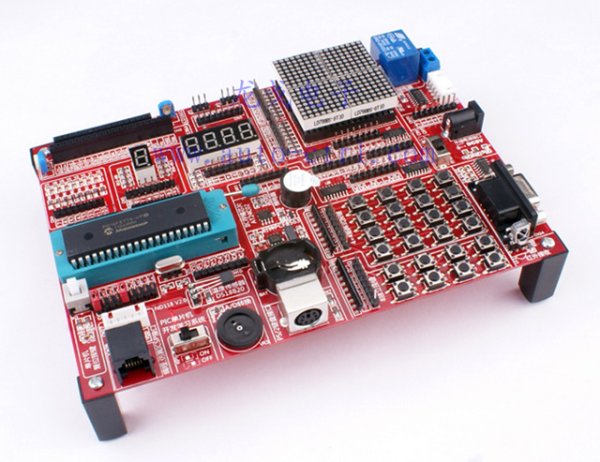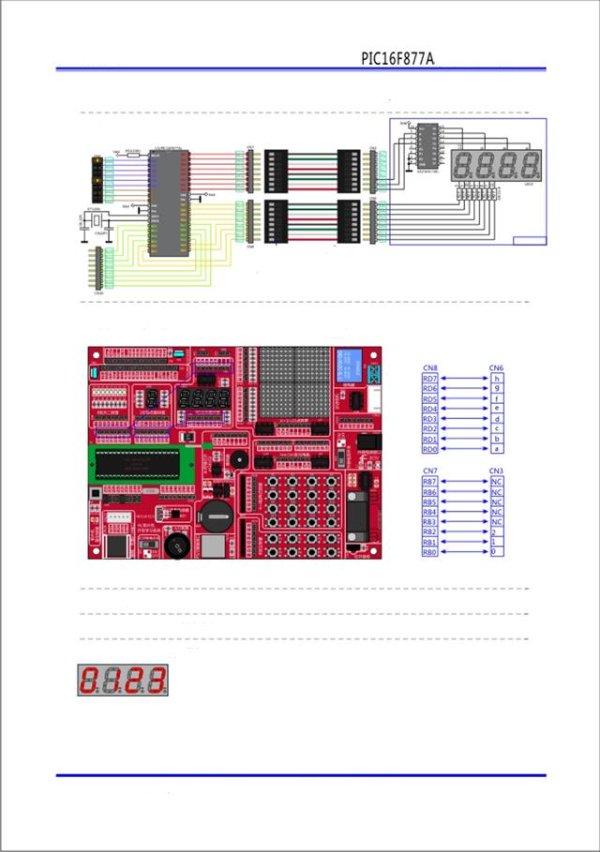Development board backplane
Plug-in part by wave soldering process , the board also neat reverse .
The curved surface of the pad foot , guaranteed not to scratch your desktop.
The system uses a fully independent module design , DIY leave enough space to the user
can use any combination of the modules for a variety of experiments.
The benefits of individual modules is self-evident , but for beginners operation is relatively
cumbersome , we prepared a detailed operating instructions for each experiment , including plug wire method ,
with plug wire schematics.This allows to users in the shortest possible time , to develop, test and fix it’s software & hardware.

Operation of the programmer is very simple, just press the icon PP2011
The programmer automatically will recognizew the board and install the communication
betwee it and the PC. You then can choose your .hex file , adjust ( if you want ) the flage
and programme the microcontroller.
Prammer Supported Devices :
PIC16F5X series : PIC16F54, PIC16F57, PIC16F59
PIC16F7X series : PIC16F72, PIC16F73, PIC16F74, PIC16F76, PIC16F77
PIC16F7X7 series : PIC16F737, PIC16F747, PIC16F767, PIC16F777
PIC16F87XA series : PIC16F873A, PIC16F874A, PIC16F876A, PIC16F877A
PIC16F88X series : PIC16F882, PIC16F883, PIC16F884, PIC16F886, PIC16F887
PIC16F91X series : PIC16F913, PIC16F914, PIC16F916, PIC16F917, PIC16F946
Board within the resource description SCM:
The standard configuration comes with a PIC16F887, the user can replace it with other DIP40 package PIC microcontroller, as :
PIC16F874A, PIC16F74, PIC16F77, PIC16F747, PIC16F777, PIC16F874, PIC16F877, PIC16F914, PIC16F917 ecc. ecc.
Light-emitting diodes: 8 green patch of light-emitting diodes, light water experiments can be done .
Digital tube: 1 red LED , digital tube early learning , this is the best , easiest to grasp the principle . 4 -digit red LED, learn static display ,
the use of this learning dynamic display four digits.
LED dot matrix : 4 x 8 × 8LED matrix , composed of 16 × 16 dot matrix screen.
1602 LCD Interface: 1602 LCD module interface. The board comes with an LCD1602 as free gift.
12864 Graphic LCD Interface: 12864 LCD module interface , the LCD module can be inserted. Text, images , animation experiment.
RTC (real time clock) : the PCF8563, crystal (32768Hz), back-up battery holder components. ( coin batery is not included)
A/D ( analog – digital conversion ) : By a potentiometer, by switching the jumper , you can experiment with any of the analog ports of the microcontroller.
RS232 serial interface : Onboard RS232 Interface circuit , you can easily use it to communicate with PC or other devices.

You can control and display ( on any display you wish) the temperature of the experiment .
PS/2 keyboard interface : You can conect any PS/2 keyboard interface , the keyboard decoding experiments .
Relays and contacts: The relay has a relay normally open contact.
IR receiver : Onboard 38KHz Integrated infrared receiver,. The set comes withan infrared remote control.
Signals can be decoded.
8 independent keys : 8 indipendent keys , each key has a pull-up resistor.
4 × 4 matrix keys : 16 keys consisting of 4 × 4 matrix , with a pull-up resistor.
For more detail: PIC microcontroller development board
